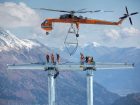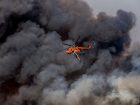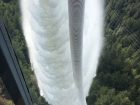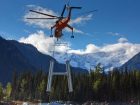
Features
Commercial
Operator Profiles
Room to Grow at Erickson
January 2, 2018 By Rick Adams
Erickson Incorporated, builder and primary operator of the unique Sikorsky S-64 Aircrane heavy lift helicopter, successfully emerged from Chapter 11 in late April 2017 after filing for bankruptcy protection from creditors in November 2016.
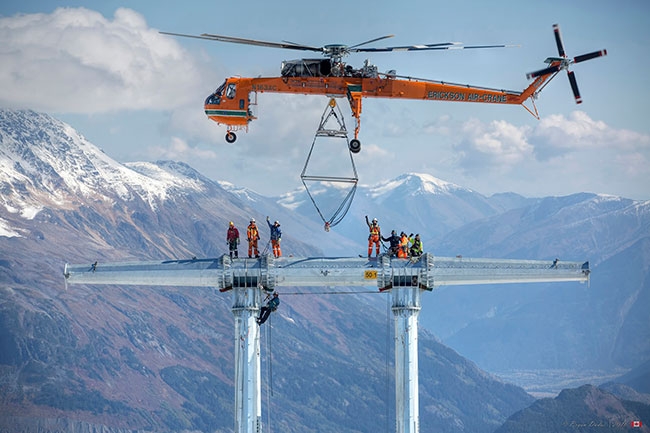 Operating in remote areas is Erickson's speciality. Erickson Incorporated
Operating in remote areas is Erickson's speciality. Erickson IncorporatedThe U.S. Bankruptcy Court for the Northern District of Texas authorized Portland, Ore.-headquartered Erickson to “rationalize” its aircraft fleet and shed more than US$400 million in debt. The new private shareholder group includes former bondholders.
Erickson’s court protection strategy was not a surprise. It had struggled since ill-advised acquisitions of Air Amazonia and Evergreen in 2013. Evergreen had substantial contracts with the U.S. Department of Defense in support of operations in Afghanistan and Iraq, as well as an offshore energy business.
But the U.S. began drawing down troop levels in the Middle East and oil prices plummeted. A lawsuit alleged that Erickson leadership, “violated their fiduciary duties by using Erickson for their own personal benefit to the detriment of Erickson’s minority stockholders.” The suit settled out of court.
Aviation industry veteran Jeff Roberts was brought in to replace Udo Rieder as CEO in April 2015. Roberts had been civil aviation group president of Montreal-based simulation and training company CAE for 11 years and previously CEO of SimuFlite. Attempting to resurrect Erickson through cost-cutting means (such as reducing the workforce from a peak of 950 to the current 700) proved insurmountable, so Roberts guided the company into the court reorganization.
Within days after announcing the emergence from Chapter 11, Roberts exited Erickson, returning to his consultancy, JG Roberts and Associates.
The new Erickson board installed Andrew Mills as interim CEO. Mills had rejoined Erickson in 2012, and was serving as general manager of aircrane operations and director of aerial services sales and marketing. He has a quarter-century of experience in helicopter operations and contracting, including general manager of Carson Helicopters and director of operations for Swanson Group Aviation.
Mills began his career in the field of geophysics, specializing in frontier exploration utilizing helicopter-supported tools. He has worked in more than 20 countries. Mills is a past chairman of the Oregon Heavylift Helicopter Consortium, and current vice chairman of the HAI government resources/firefighting committee.
In August 2017, Mills had shifted to his role of president of commercial aviation when Erickson hired merger and acquisition specialist Doug Kitani as CEO. Helicopters’ Rick Adams spoke with Mills at Erickson’s MRO and maintenance facility in Central Point, southern Oregon (close to Medford).
How has the company changed over the past year?
AM: Overall, I’m very optimistic about Erickson’s future now. We have a very manageable ledger sheet. We de-leveraged the company in terms of its debt to earnings by almost five to one. We’re probably healthier than we’ve been in several years financially. We have excellent liquidity now. We’ve gotten away from the things that were essentially dragging the company down.
We’ve obviously gone through a lot of turbulence in the past two years. But we have emerged from the bankruptcy, I think, much, much stronger. The bankruptcy itself went about as well as it could go. We were in and out of bankruptcy in five months, which by U.S. standards for a company of this size is pretty darn fast.
When we went into bankruptcy we were carrying a huge amount of debt and we had a lot of onerous aircraft leases on light and medium aircraft. Some of those aircraft did not even fly and we were paying lease payments on them. A lot of that came from the former Evergreen. And a lot of our markets had taken a downturn. Oil and gas was down. We were down some in U.S. firefighting. So, it was an unhappy confluence of a lot of our markets taking a large downward turn and the large amount of debt and aircraft leases we had to constantly pay out on.
Now that we’ve emerged from bankruptcy, we have shed the large majority of that debt, over US$400 million. We dropped all of those aircraft leases that were not good for us. We are out from under that. Or we have renegotiated with some of the lease companies, some of whom have been really good to deal with.
One thing that I’m particularly proud of: everybody at Erickson worked very hard during the bankruptcy. We lost very few people; very few left us. And of all our major customer base, we did not lose any of them; they all stayed with us. We did not lose any existing contracts. We’re still servicing all of those contracts. They basically had faith that we would come out of this thing intact and in better shape and we have.
Erickson now has a fleet of a little less than 50 aircraft, and all the aircraft we have are operational or trainers and flying on contracts; that is a change from where we were a year ago. We’re much leaner.
We’ve centred our rotorcraft fleet around the Aircrane platform and a couple of medium platforms, the Bell 214ST and the Puma 330J. And we have a small number of fixed wings, a CASA 212 and Beech 1900D, that we use in support of some of our government contracts.
What are your primary markets and key customers?
AM: Our company operates in three major business segments. One is civil aviation where we do firefighting, logging, power line construction work, precision placement. The other flight portion of our business is government services, flying in support of various government contracts. The third major segment of our business is our MRO group.
We have existing contracts in Australia for firefighting. We have six Aircranes on contract every year for firefighting with the NAFC (National Aerial Firefighting Centre). NAFC renewed the two option years of our contract at the beginning of last year; they stuck with us. We have contracts with the NSPA (NATO Support and Procurement Agency), which is the civilian contracting arm for firefighting in Greece. We have three aircraft in Greece. They have also renewed our contract.
We have Canadian logging customers that have stuck with us. We have aircraft operating up there now. During the course of the year, we have two to four aircranes working in Canada. We have some longstanding heli-logging contracts. We do timber harvesting from the air, mostly in B.C. We do work for Western Forest Products, which is a very large Canadian timber company. Also HeliFor, a Canadian heavy lift company, pretty much year round.
In the last couple of years, we’ve seen a steady uptick in precision power line construction. We build the power line towers from the air for these larger-scale power line projects in northern Canada. That work is done for a multitude of different contractors. We’re probably going to do more of that work this year than we have in the past several years.
What is the nature of some of your government support services contracts?
AM: We fly humanitarian and personnel and supply missions in support of U.S. government contracts in several different parts of the world.
We also have the U.S. Navy VERTREP (Vertical Replenishment) contract. We have three detachments of the Navy VERTREP program; essentially, they use our Puma 330J helicopters to transfer supplies to and from ships via helicopter. They do it at sea while they’re underway, so it’s very efficient. (In June 2016, Erickson announced the award of two, five-year term agreements to provide vertical replenishment and other rotary-wing logistic services to Military Sealift Command for support of the Navy’s 5th and 7th Fleets. Erickson has performed VERTREP operations for the U.S. Navy since 2004.)
Each of those government contracts requires certain levels of recurrent training and we have a couple aircraft that we keep cycling on a regular basis for that.
And you’re still building new Aircranes?
AM: We are the type certificate holder for both the airframe and the powerplant. We bought the engine type certificate from Pratt and Whitney a few years ago. We are also the Bell Service Centre for the Bell 214ST, and we have our own fleet of those aircraft. So we do a lot of our own fleet heavy maintenance and we build components for those aircraft. In addition, we do outside work for other Aircrane/Skycrane customers and Bell customers, and refurbishment for U.S. government customers on heavy helicopter platforms.
We are currently building a new S-64E Aircrane for the Korean Forest Service; that aircraft is well underway. It is a replacement aircraft for them. We have built four for them in the past, and they really like this aircraft. They like the performance.
There are about 40 total Aircranes and Skycranes flying in the world; we have 20. Ours are all called the Aircrane. We bought the type certificate from Sikorsky in the ’90s. The Erickson product is a standard civilian category Aircrane. The aircraft we build for other customers are all standard civilian category Aircranes.
There are other operators that are still flying the military surplus restricted category Skycrane. The Skycrane are the original Sikorsky products. Performance-wise, they are the same aircraft.
How has Erickson improved on the original S-64?
AM: We’ve engineered a lot of improvements to the Aircrane. Because we have our own operating fleet of these aircraft and we fly more Aircrane hours than anybody in the world, we are constantly improving and upgrading them. We developed the first large helicopter firefighting water drop tank-and-snorkel system, and we think it’s still the best. You fill the water with a hydraulic snorkel into a tank that has computer-controlled coverage drop levels. And it has proven itself over and over again all around the world.
Then we developed the sea snorkel, which allows us to fill the tank in 30 seconds from saltwater environments at 50 knots of forward airspeed. We’ve upgraded the cockpit avionics over the years.
We are also nearing the final stages of a composite blade rotor program for the Aircrane. We started the program several years ago, and we’re very close to certification of the blades. We expect to really enhance the performance and operating maintenance costs on the Aircrane. We’ve engineered it so it is exactly the same weight as the existing blades. That solves a lot of the harmonic issues. It will be a retrofit bolt-on to the existing fleet. We’ve done most of the flight testing and expect to have the blades FAA-certified by the end of the year.
We’ve done close to 200 improvements to this aircraft.
The previous Erickson leadership were criticized, even sued, for questionable decisions such as Evergreen. What’s the makeup of the new owners and board?
AM: We have a diverse group of new owners, private ownership. Several of them are former bondholders. Erickson had a lot of debt. When they bought the former Evergreen, they borrowed a lot of money, a lot of it through bonds. Some of our current owners are former bondholders. The transition, as we came out of bankruptcy, was actually relatively smooth because several of them were already with the company.
We have a completely new board, a mix of industry professionals and some high-level business folks from outside the aviation industry. The former ownership and shareholders are all gone. No one associated with the acquisitions that led to the difficulties is involved in the company.
The board has given me full authority to run the company and we are in the process of making a lot of constructive changes.
Where does Erickson go from here?
AM: We want to grow our footprint in our existing markets. We think there’s room for some more growth in the places where we do our best work, which includes firefighting and power line. Historically we’ve done a bit of oil and gas work, moving heli-portable drill rigs in remote areas. That market has been way down because of the drop in oil and gas. We still do some of that in South America. I think in the next couple of years that will start to slowly uptick again. We fully intend to grow that market.
We have quite a bit of room for growth in our government services side. We are very highly rated by the government contracting agencies for our performance in the field. We think there’s room for growth in that market in support of government contracts and UN relief work.
Erickson’s forte, what we do best, is operating in very remote, difficult environments, and keeping the aircraft and the crews safe and up and flying. Our operational readiness rates are among the best in the industry – in very difficult places. Not all operators have that capability; that’s what we specialize in.
And I see a fair bit of room for growth in our MRO group. We have some unique capabilities. Because we had to develop a lot of engineering capability, machining capability, and speciality one-off capability – just to keep our Aircrane fleet current – we’re now branching out into some other legacy platforms to offer MRO services and to do speciality work for major OEMs like Bell and Sikorsky. It’s the small, individual engineering or machine projects that they don’t really want to deal with. It’s for somebody who needs 10 of something, not 1,000 of something. Or they need a speciality part machined for an aircraft they still service but they’ve moved on. They contract us to do things like that.
The best example is that the U.S. military wants to keep their current MH and CH53E Super Sea Stallion fleet operational; it’s going to be awhile before they get the K model (with a program-of-record requirement for 200 CH-53Ks, the Marine Corps is targeted initial operations of the K model in 2019). They have contracted a few different providers to refurbish those aircraft and we are one of the contracted parties. We build the tail boom for that aircraft from scratch under contract from Sikorsky.
Erickson has been a mainstay in the rotorcraft industry for 40-years plus, and I’m feeling about as good about the company as I have in a long time. We are financially strong now. We have owners that want to see us grow. We have good liquidity. We’ve been able to keep our workforce and our customer base intact through the tough times. I really feel like we’re on the other side of that now.
A lot of times in these processes companies get broken up, portions of them get sold off, they emerge from this process a significantly different company than they were before. For us, the message is we have retained all our strengths. We have retained our manufacturing capability. We’ve retained our maintenance capability. We now have the ability to enhance what we do, to grow our markets, and throughout this process we have kept our safety records at the highest levels; that’s one thing we’ve never sacrificed no matter what. And I think we are safer, leaner, and stronger than we’ve been in several years.
